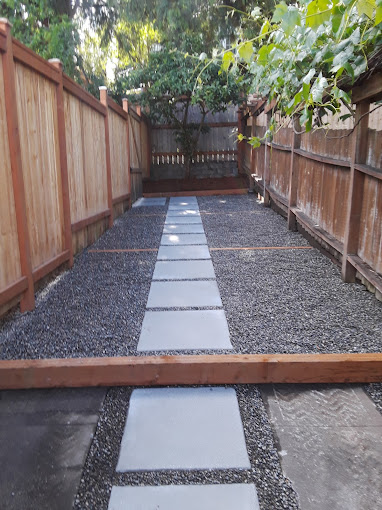A gravel swale is an effective, environmentally friendly landscape feature designed to capture and filter rainwater. This shallow ditch filled with gravel and plants helps reduce stormwater runoff, improves water absorption, and adds a beautiful, functional element to your yard. Here’s a comprehensive guide on how to create your own gravel swale.
Step 1: Design and Planning
- Assess Your Yard:
- Identify a low-lying area or natural depression where water tends to collect after rainfall. This will be the best spot for your swale.
- Determine the Size:
- Decide on the length, width, and depth of your swale based on available space and the amount of rainfall you want to capture. The swale should be deep enough to hold water temporarily, but not so deep that it becomes a pond.
- Choose the Right Gravel:
- Select porous gravel or decomposed granite, which allows water to infiltrate effectively. Avoid larger gravel that may not allow for adequate water absorption.
Step 2: Installation
- Mark the Area:
- Use a rope, garden hose, or chalk to mark the swale’s perimeter. This will give you a clear outline of where to dig.
- Dig the Swale:
- Dig a shallow ditch about 2-4 inches deep and 6-12 inches wide. The swale should gently slope to allow water to flow through without pooling.
- Add a Check Dam:
- To help slow down the flow of water and promote infiltration, create a small check dam using rocks or gravel. This will ensure water has time to soak into the soil rather than running off quickly.
- Fill with Gravel:
- Fill the swale with your chosen gravel, leaving enough space for water to collect but still allowing it to drain. The gravel should be distributed evenly, creating a bed that facilitates water flow and absorption.
- Plant Vegetation:
- Along the swale’s edges and floor, plant water-loving plants, such as sedges, rushes, or native grasses. These plants will help stabilize the soil, filter the water, and add beauty to your swale.
Step 3: Maintenance
- Monitor and Maintain:
- Regularly check the swale to ensure it is functioning properly. Ensure water is filtering through the gravel and not pooling in one area.
- Keep It Clean:
- Over time, debris or sediment may accumulate in the swale. Remove any debris, such as leaves or twigs, to keep the flow of water uninterrupted.
- Water and Mulch:
- Water plants regularly, especially in dry conditions, to help them establish. Add a layer of mulch to retain moisture and suppress weed growth. This will also keep the plants healthy.
Benefits of a Gravel Swale:
- Reduces Stormwater Runoff:
- Gravel swales capture rainwater and allow it to infiltrate the soil, reducing surface runoff that can lead to erosion and flooding.
- Filters Rainwater:
- As water flows through the gravel, it gets filtered before reaching the groundwater, reducing pollution and improving water quality.
- Creates Habitat for Wildlife:
- The plants and soil in the swale create an ideal environment for various wildlife species, supporting biodiversity in your yard.
- Adds Beauty to Your Landscape:
- Swales can be a beautiful feature that enhances the aesthetics of your garden, especially when filled with colorful plants and natural stones.
- Low Maintenance:
- Once established, gravel swales require minimal maintenance, making them an excellent addition to your landscape.
Additional Considerations:
- Local Regulations:
- Always check with your local government or homeowner association for any regulations related to stormwater management or yard modifications before starting your project.
- Consulting an Expert:
- If you’re unsure about the specific drainage needs or design for your swale, it’s always a good idea to consult a landscaping professional or stormwater management expert.
Conclusion
Building a gravel swale is a practical and eco-friendly way to manage rainwater in your Seattle yard. Not only will it reduce stormwater runoff, but it will also enhance the beauty and health of your garden. By following this simple step-by-step guide, you can create a functional and attractive landscape feature that benefits both the environment and your outdoor space.
Happy landscaping, and don’t hesitate to reach out to Lee’s General Landscaping if you need professional help with your swale installation or any other landscaping projects!



















